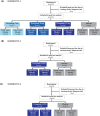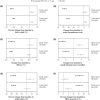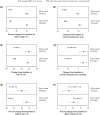Early-Onset Obesity and Tirzepatide Treatment: A Post Hoc Analysis of the SURMOUNT Clinical Trials
- PMID: 40717199
- PMCID: PMC12381612
- DOI: 10.1002/oby.24348
Early-Onset Obesity and Tirzepatide Treatment: A Post Hoc Analysis of the SURMOUNT Clinical Trials
Abstract
Objective: People with early-onset obesity (diagnosed at age < 25 years) may present with more cardiometabolic abnormalities and obesity-related complications. This post hoc analysis assessed baseline characteristics and body weight (BW) changes with tirzepatide in people with early- versus later-onset obesity.
Methods: Participants (N = 3782) from SURMOUNT-1, SURMOUNT-3, and SURMOUNT-4 randomized to tirzepatide or placebo were included. Baseline characteristics and changes in BW and cardiometabolic risk factors at 72/88 weeks were assessed.
Results: In SURMOUNT-1, participants with early- versus later-onset obesity had longer mean obesity duration (20 ± 12 vs. 11 ± 8 years), higher BMI (40 ± 7 vs. 37 ± 6 kg/m2) and waist circumference (WC, 118 ± 16 vs. 112 ± 14 cm), and lower HbA1c (5.48% ± 0.4% vs. 5.60% ± 0.4%), triglycerides (median 120 vs. 130 mg/dL), and systolic blood pressure (SBP; 121 ± 13 vs. 125 ± 13 mmHg) at baseline (all p ≤ 0.004). At 72 weeks, improvements with tirzepatide in BW (-23% vs. -22%), WC (-22 vs. -19 cm), HbA1c (-0.51% vs. -0.52%), triglycerides (-32% vs. -31%), and SBP (-8 vs. -8 mmHg) were similar between subgroups. Similar improvements were observed in SURMOUNT-3 and SURMOUNT-4.
Conclusions: In this post hoc analysis, participants with early- versus later-onset obesity exhibited a mixed profile of metabolic health at baseline, including a higher degree of central adiposity and lower HbA1c and SBP. Improvements in BW and cardiometabolic markers with tirzepatide were similar between subgroups.
Trial registration: ClinicalTrials.gov identifiers: NCT04184622, NCT04657016, NCT04660643.
Keywords: early‐onset; obesity; tirzepatide.
© 2025 Eli Lilly and Company and The Author(s). Obesity published by Wiley Periodicals LLC on behalf of The Obesity Society.
Conflict of interest statement
E.G. has received a travel award from Eli Lilly and Company. G.S. reports consulting fees from Rhythm, Novo Nordisk, and Eli Lilly and Company. A.S.K. engages in unpaid consulting and educational activities and serves as an unpaid investigator for Novo Nordisk; engages in unpaid consulting activities and serves as an unpaid investigator for Boehringer Ingelheim, Eli Lilly and Company, and Vivus; and receives donated drug/placebo from Novo Nordisk and Vivus for National Institute of Diabetes and Digestive and Kidney Diseases (NIDDK)‐funded clinical trials. D.M., D.C., M.A.M., C.A.K., and C.J.L. are employees and shareholders of Eli Lilly and Company.
Figures




References
-
- Cheng H. L., Medlow S., and Steinbeck K., “The Health Consequences of Obesity in Young Adulthood,” Current Obesity Reports 5, no. 1 (2016): 30–37. - PubMed
-
- Lee C. D., D. R. Jacobs, Jr. , Schreiner P. J., Iribarren C., and Hankinson A., “Abdominal Obesity and Coronary Artery Calcification in Young Adults: The Coronary Artery Risk Development in Young Adults (CARDIA) Study,” American Journal of Clinical Nutrition 86, no. 1 (2007): 48–54. - PubMed
-
- Patton G. C., Coffey C., Carlin J. B., et al., “Overweight and Obesity Between Adolescence and Young Adulthood: A 10‐Year Prospective Cohort Study,” Journal of Adolescent Health 48, no. 3 (2011): 275–280. - PubMed
Publication types
MeSH terms
Substances
Associated data
Grants and funding
LinkOut - more resources
Full Text Sources
Medical

